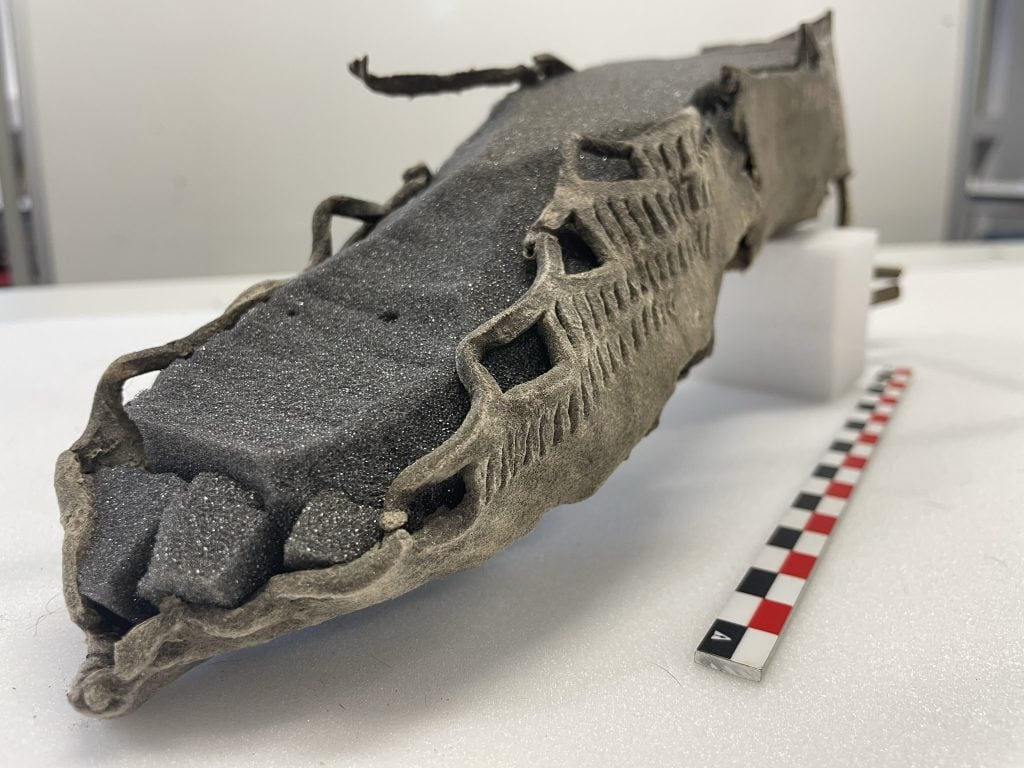Archaeology & History
Archaeologists Have Discovered a 1,700-Year-Old Leather Sandal, an Example of Ice-Age Fashion, on a Mountain Pass in Norway
Experts believe the sandal is a version of the Roman carbatina, a popular style in Europe at the time.

Experts believe the sandal is a version of the Roman carbatina, a popular style in Europe at the time.

Artnet News

It was a shoe drop very different from those that fuel Hypebeast articles and eBay listings today.
Thanks to melting ice, archaeologists have discovered a 1,700-year-old leather sandal left behind by a traveler passing through Horse Ice Patch in what, today, is Oppland, Norway. Experts believe the shoe, which has been radiocarbon-dated to about 300 C.E., was discarded by its owner after being worn out.
A hiker spotted the Iron Age sandal sticking out of the snow in August of 2019. He promptly contacted Secrets of the Ice, a group of archaeologists who study glaciers and ice patches in Norway—and did so just in time, as a winter storm was about to set in, threatening to cover the object indefinitely.
“It could take many years before it melted out again,” Espen Finstad, the lead archaeologist on the project, told Live Science. “We archaeologists had a day to go in and collect the find.”
Elements be damned, Finstad and his team excavated the sandal, as well as other artifacts in the area, including textiles, arrow shafts, and frozen horse manure from the Viking Age (roughly 800 C.E. to 1066 C.E.). “It was a long day,” Finstad recalled. The next day the area was blanketed in snow.
The group announced its finding this month.
There was a lot of ice melt in 2019. We were busy rescuing finds from the Lendbreen pass and other sites. Just before winter snow arrived, we received an exciting photo from the Horse Ice Patch pass from a mountain hiker. Isn't that an Iron Age shoe? We rushed to the pass. pic.twitter.com/71GmpQVinX
— Secrets Of The Ice (@brearkeologi) April 8, 2022
Vegard Vike, a conservator at Oslo’s Kulturhistorisk Museum, took to Twitter to explain that the sandal was a version of the Roman carbatina, a style popular in Europe around the same time.
“It’s pretty astonishing,” Finstad told Science Norway. “[W]e’re up here at almost [6,500 feet], and we find a shoe with fashion elements similar to those found on the continent at the time.”
While the sandal isn’t the first piece of footwear found on the mountain, it is the only example of its kind. Previous shoes discovered in the area were made of large pieces of animal skin meant to protect the foot from the snow. “It’s easy to joke about a Roman tourist who didn’t quite understand much about the country he was visiting,” the archaeologist added.
Hide shoe found in the mountains of Oppland, Norway 2019. While participating in its conservation @kulturhistorisk earlier this year I took some photos and made a drawing before it was reshaped in preparation for freeze drying.
1/4 pic.twitter.com/9U2TWhdnzY— Vegard Vike (@VegardVike) July 4, 2021
Regardless of its origins, the sandal, like other objects found nearby, prove that the icy mountain pass has been used by travelers journeying from inland Norway to the coast.
“It tells us that what today looks like a wild and desolate mountain landscape has been a prehistoric traffic landscape, and that it is full of traces of humans,” Finstad told Live Science. “People have not been afraid to move out into tough mountain areas. They have traveled long distances and had contact and exchange.”